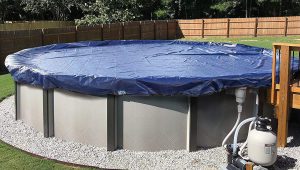
This fall has been unusually warm, giving us a few extra weeks of sunshine. While it’s tempting to keep the pool parties going, the calendar doesn’t lie—cooler temperatures are just around the corner. Now is the perfect time to start thinking about properly winterizing your pool and backyard. Taking these steps ensures your outdoor oasis weathers the winter months and is ready for fun when spring returns.
Properly closing your pool and storing your outdoor furniture is about more than just tidiness. It’s a crucial investment in protecting your property from damage caused by freezing temperatures, snow, and ice. A little effort now can save you from significant, costly repairs later. This guide will walk you through the essential steps for a smooth and effective winterization process.
Before you focus on the pool itself, let’s prepare the surrounding area. Your patio furniture, grill, and other outdoor accessories need protection to last for years to come.
You might think only wood patio furniture needs to be brought indoors, but all materials are at risk during harsh winters.
Before storing, give every piece a thorough cleaning. Wipe down tables, chairs, and cushions to remove dirt, pollen, and food residue. Make sure everything is completely dry to prevent mold and mildew from growing in storage. Store your furniture in a dry, sheltered location like a garage, shed, or basement.
Don’t forget the smaller items that make your backyard complete. Pool floats, toys, and umbrellas should also be cleaned, dried, and stored. Leaving them outside can cause colors to fade and materials to degrade. Fabric items like umbrella canopies and cushions are especially susceptible to mold and mildew if left out in the damp winter air. A clean and dry storage space will keep them in great condition for next season.
With your backyard clear, it’s time to give your pool the attention it needs. A proper shutdown procedure is vital for protecting your pool’s structure and equipment from the damaging effects of ice and freezing water. Neglecting these steps can lead to cracked pipes, damaged liners, and broken pumps—repairs that can be very expensive.
The first step is to get your pool as clean as possible. Remove all leaves, dirt, and debris with a skimmer and a pool vacuum. Brush the walls and floor to dislodge any algae or sediment that has settled. A clean pool is less likely to develop stains or algae blooms over the winter, making for a much easier spring opening.
Once your pool is clean, it’s time to test and balance the water. Unbalanced water can become corrosive over the winter, potentially damaging your pool’s surfaces and equipment. Test the pH, alkalinity, and calcium hardness levels and adjust them as needed to fall within the ideal ranges.
After balancing, “shock” the pool with a chlorine treatment. This high dose of chlorine will eliminate any remaining bacteria, algae, and other contaminants. Let the pump run for several hours to circulate the shock treatment throughout the pool. Finally, add a winterizing algaecide to prevent algae growth during the offseason.
To prevent freeze damage to your skimmers and tiles, you’ll need to lower the water level. The exact level depends on your pool type and the kind of winter cover you use. Generally, the water should be drained to about 4 to 6 inches below the skimmer line. This ensures that freezing water won’t crack the skimmer housings or tiles as it expands.
Next, drain all water from your pump, filter, heater, and chlorinator. Any water left inside this equipment can freeze, expand, and cause serious cracks. Follow your manufacturer’s instructions for draining each component, and be sure to remove all drain plugs. Store these plugs in the pump basket so you can easily find them in the spring.
Remove and store any ladders, handrails, diving boards, and other pool accessories. Cleaning them before storage will keep them in top shape.
The final step is to cover your pool with a high-quality winter cover. A good cover will keep out debris, sunlight, and precipitation, ensuring the water stays clean. Sunlight can encourage algae growth, even in cold water, so an opaque cover is best.
Make sure the cover is secured tightly to prevent it from blowing off in high winds. For in-ground pools, this may involve using water bags or safety anchors. For above-ground pools, a cable and winch system is typically used. A snug fit is key to a clean pool in the spring.
While your pool takes a well-deserved winter break, your hot tub is ready for its time to shine. There’s nothing quite like soaking in the warm, bubbling water while the air is crisp and cool. Hot tubs are designed for year-round use, and enjoying one during the winter months is a special treat. Just be sure to maintain your water chemistry and keep the cover on when it’s not in use to retain heat and keep energy costs down.
Winterizing your pool and backyard can feel like a big job, but it’s a critical part of responsible pool ownership. Following these steps will protect your investment and guarantee a hassle-free opening next spring.
If you need assistance with your pool closing or have any questions about the process, we’re here to help. Sunny’s Pool & More! has all the winterizing chemicals, covers, and expertise you need to get the job done right. Contact us or visit one of our locations today
Posted In: Closing a Pool
Tags: hot tubs in winter, winterizing pools